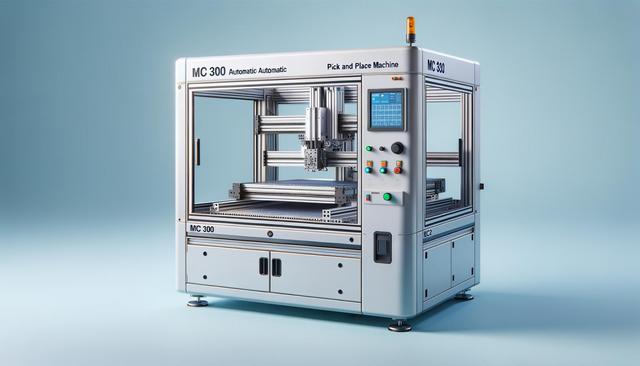Understanding the Role of the MC 300 in PCB Assembly
The MC 300 automatic pick-and-place machine is engineered to streamline the printed circuit board (PCB) assembly process by automating the precise placement of components. In modern electronics manufacturing, efficiency and accuracy are critical, and the MC 300 addresses both needs with a well-balanced combination of speed and control. By automating repetitive and delicate placement tasks, this machine significantly reduces manual labor while enhancing production consistency. Its functionality is especially beneficial for small to mid-scale production runs, where maintaining a high level of quality is essential across varying batch sizes.
Designed to handle a wide range of surface-mount devices (SMDs), the MC 300 supports components of different shapes and sizes, making it a versatile choice for manufacturers working with complex board layouts. Whether for prototyping or volume assembly, the machine’s adaptability helps reduce setup time and simplifies process customization. With its ability to manage diverse component types, the MC 300 becomes a valuable asset in electronics manufacturing environments that require both speed and flexibility.
Key Features That Enhance Performance
Several features contribute to the MC 300’s performance in the automated assembly of PCBs. These include advanced vision systems, precise component feeders, and a user-friendly interface that allows for efficient programming and operation. Each element plays a distinct role in ensuring accurate and repeatable results.
Some of the standout features include:
- High-speed placement head for rapid throughput
- Vision alignment system for precise positioning
- Feeder compatibility with various reel and tray formats
- Intuitive touchscreen controls for simplified setup
The MC 300 is built with a focus on minimizing component misplacement and ensuring that even the smallest parts are handled delicately. Its vision system aids in correcting alignment errors before placement, which significantly improves overall yield rates. Moreover, its modular design allows users to upgrade or adjust specific features as production needs evolve, making it a scalable solution for growing operations.
Efficiency Gains in Automated Production
One of the biggest advantages of the MC 300 is the enhanced production efficiency it brings to the assembly line. By automating the pick-and-place process, manufacturers can reduce downtime, limit human error, and speed up overall throughput. The consistency delivered by automation not only improves product quality but also helps meet tight delivery deadlines.
Efficiency is further supported by features such as:
- Quick-change feeder systems for minimal setup time
- Real-time diagnostics and machine status monitoring
- Batch processing capabilities for uninterrupted operation
These elements combine to create a smooth workflow that supports lean manufacturing principles. The MC 300’s ability to maintain a high cycle rate while minimizing waste directly contributes to lower operational costs and improved profitability over time. With its automation capabilities, manufacturers can shift resources from manual assembly to higher-value tasks such as design optimization and quality control.
Software Integration and User Experience
Beyond hardware, the MC 300 also delivers a seamless software experience that enhances usability and integration within existing production environments. The machine comes equipped with software tools that support CAD data import, component library creation, and job management. These features reduce the time it takes to configure new projects and allow for efficient process repeatability.
Highlights of the software capabilities include:
- Graphical user interface (GUI) for intuitive navigation
- Support for multiple file formats including standard Gerber and CSV
- Real-time component tracking and usage reports
The software is designed to cater to both experienced operators and newcomers, with step-by-step guides and built-in error checking to prevent costly mistakes. Remote access and update capabilities also ensure that the system remains current with the latest firmware and software improvements. This level of integration simplifies training and reduces the learning curve, making it easier to bring new team members up to speed.
Applications Across Industries
The MC 300 automatic pick-and-place machine finds applications across various industries where PCB assembly is a core requirement. Its flexibility and performance make it suitable for sectors such as consumer electronics, automotive electronics, medical devices, and industrial control systems. Each of these industries demands a high level of precision and reliability, which the MC 300 is well-equipped to deliver.
Common use cases include:
- Assembly of compact, multi-layer PCBs for wearable technology
- Production of control modules for automation systems
- Manufacturing of medical monitoring and diagnostic equipment
Due to its scalable nature, the MC 300 can be used effectively for both prototyping and full-scale production. This versatility is particularly valuable for contract manufacturers who must adapt quickly to different client requirements. By delivering consistent performance across project types, the MC 300 helps maintain high standards regardless of industry or product complexity.
Conclusion: A Reliable Solution for Modern PCB Assembly
For manufacturers aiming to enhance their PCB assembly processes, the MC 300 automatic pick-and-place machine represents a dependable choice. Combining speed, precision, and flexibility, it supports a wide range of production needs while maintaining consistent output quality. Its advanced features and intuitive software contribute to smoother operations and reduced downtime, making it a practical investment for growing production facilities. Whether in a high-mix, low-volume environment or a full-scale manufacturing line, the MC 300 offers the tools needed to meet modern electronics assembly demands efficiently and reliably.




Leave a Reply